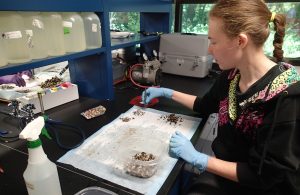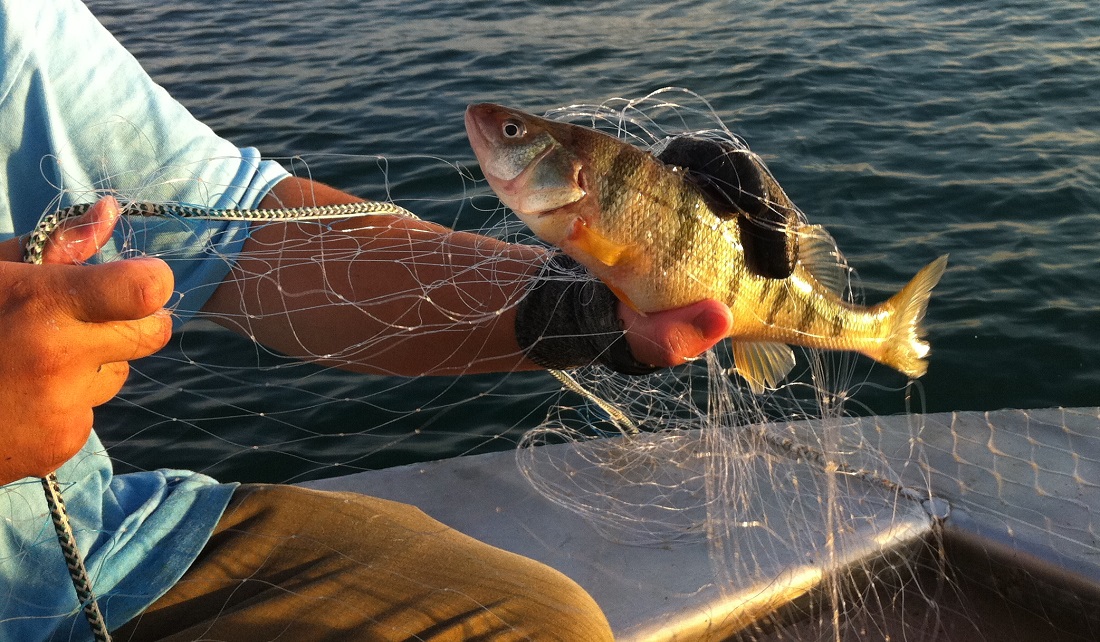October 10th, 2018 by IISG
Crystal Hall is interning with Illinois-Indiana Sea Grant (IISG) as a recent graduate of Purdue University Northwest (PNW) with a B.S. in Biology and a concentration in Ecology. Funded by IISG and mentored by Leslie Dorworth, an aquatic ecology specialist with IISG and PNW, Hall is positioned with the U.S. Geological Survey to carry out work that moves projects forward through IISG, the U.S. Army Corps of Engineers and the Indiana Department of Environmental Management.
When I started my internship working with the U.S. Geological Survey (USGS), I had no idea what I wanted to do career-wise other than something with fish. To be honest, I still don’t fully know. Over the six months I have spent at USGS, I have learned a great deal of information and have gotten to know a wonderful group of people.
I have worked on several projects and learned new things from each:
Round Goby Mesocosm
The purpose of the round goby mesocosm project is to look at the shed and decay rates of round goby DNA in water and sediment. Several round goby were placed into a tank, and weekly water and sediment samples were taken for environmental DNA (eDNA). After a set amount of time, the round goby were removed and weekly water and sediment samples continued to be taken to see how long before no round goby DNA was detected. Throughout this project, I learned a lot about eDNA and how concentrations are different in water and sediment.
Cladophora

Hall separates zebra mussels from quagga mussels on June 4, 2018. (Photo U.S. Geological Survey)
On the Cladophora project, we deployed EXO2 water quality sondes in the Great Lakes and collected samples of dreissenid mussels and Cladophora algae from several depths and quadrants for biomass and nutrient processing. Researchers are seeking to understand the influence of phosphorus on Cladophora growth. I have learned to successfully identify zebra mussels from quagga mussels. And I’ve learned that it is not zebra mussels invading the Great Lakes anymore—it’s quagga mussels.
Area of Concern
We test for E. coli in the water at Whihala Beach and Hammond Port Authority, which are part of the Grand Calumet River Area of Concern. This information is used to notify the public of whether the beach is safe for swimming. Scientists used to test several other beaches in the area as well, but many were removed from the project because the water quality improved and met standards.
Artificial Reef
A year ago, an artificial reef was put in at Jeorse Park Beach by the U.S. Army Corps of Engineers as part of a large-scale restoration project for the beach. The U.S. Army Corps were hoping the reef would attract a number of native fish species that had once been in the area. In the artificial reef project I’m working on, I am assisting a master’s student with research that aims to see if this artificial reef has actually attracted native fish, or if round goby have colonized the reef since they’re attracted to rocky substrate.
Monthly water samples are taken and filtered for eDNA from several locations at Jeorse Park Beach, including surface water samples at the reef and water samples right above the substrate of the reef. After the sampling is complete, the DNA will be sequenced using fish primers for fish found in Lake Michigan to determine the composition of fish in the water based on the eDNA. Part of the project will be comparing the eDNA to traditional methods of monitoring (e.g., electroshocking).
I’ve learned so much. Before this internship, I knew nothing about freshwater reefs and artificial reefs. I didn’t know that breakwalls altered the flow of water in a way that can cause a buildup of E. coli and lead to unsafe water conditions. When I began my internship, everyone would talk about ongoing projects and try to inform me about the details of each one, but there was a lot that I didn’t understand. I’m proud to say that has changed, and now I am able to explain to others the projects we are doing, why we are conducting research in certain ways and what we are hoping to find.
I’m thankful for the opportunity to intern at USGS through Illinois-Indiana Sea Grant and to work with a great group of people. I have definitely gotten more out of my internship than I was ever expecting, and while I still don’t know what I would like to do as a career choice, I’ve discovered that working on projects like these is certainly an option and something I very much enjoy.
Learn more about our internship opportunities online, or contact Angie Archer at (765)496-3722, amcbride@purdue.edu.
Illinois-Indiana Sea Grant is a part of University of Illinois Extension and Purdue University Extension.
December 6th, 2017 by iisg_superadmin
Environmental DNA, or eDNA, had a moment in the limelight around 2010, when through the use of this monitoring tool, researchers found evidence of Asian carp in Chicago waterways past the electric barrier installed to stop these fish, and within range of Lake Michigan.
This news, along with several captures of Asian carp in local waters, alerted resource managers and other decision makers to the status of these fish that pose a threat to the Great Lakes.
Environmental DNA is detected in traces of shed skin, hair, mucus and waste, for example, that an organism leaves behind in its surroundings. This monitoring tool was initially used to survey microorganism biodiversity and to sample ancient DNA in soil or ice cores. In the past decade or more, eDNA sampling has been used in lakes and rivers to check for the presence or absence of a species as well as quantifying how many species are found in the waterway.
“Through the newest method, eDNA metabarcoding, we can identify the presence of all fish species inhabiting a body of water,” said Nathan Evans, a postdoc at Florida International University. With Illinois-Indiana Sea Grant funding, Evans, while a graduate student at the University of Notre Dame, assessed the effectiveness of eDNA for conservation management through a literature review of related studies.
He found that eDNA sampling has some advantages over traditional sampling, which include netting fish, electrofishing, or doing visual surveys. These methods are effort intensive and typically have low detection probabilities for rare species, meaning that there is a smaller chance that these less abundant species will show up in sampling.
“Whether in fish or bird or mammal communities, the typical pattern is that they are comprised of a few very abundant species, and large numbers of rare species,” he explained. “Using eDNA increases detection probabilities for those rare species.”
But eDNA sampling is not a replacement for traditional monitoring methods. “With traditional sampling, you are holding the fish, you can measure many more aspects, including size and sex,” said Evans. “With eDNA, you are learning if the fish is there or not, and possibly its abundance.”

Through traditional sampling, researchers can gather information about the status of yellow perch in Great Lakes waters.
As part of Gary Lamberti’s lab at Notre Dame, Evans also engaged in field research on the costs and effectiveness of using eDNA to sample water bodies. Currently, eDNA is more costly than traditional sampling, but is more effort efficient—it provides a more thorough sample of a system with less effort.
Going forward, he sees eDNA costs coming down and the process getting faster, potentially providing the technology to have immediate information in the field. And, research related to eDNA transport is growing. “Right now we sample downstream to learn about fish that are upstream. But we don’t know how far upstream they are—it could be two feet or 20 miles,” Evans said. “The technology will advance to enable us to pinpoint where species are in a watershed. This will revolutionize species management and ecological research.”
This literature review is published in the January 2018 issue of Fisheries Research.
April 9th, 2015 by iisg_superadmin
In the Great Lakes region, the word “eDNA” is never far from “Asian carp.” And for good reason. The technology was originally applied by Notre Dame scientists in response to the federal government’s need to discover—and ultimately control—the spread of this voracious invader.
But in the six years since, environmental DNA has become a commonly used tool for detecting fish and other aquatic organisms. Biologists in the UK use it to locate crested newts, Kentucky scientists use eDNA to monitor salamanders, and a city in Washington state even plans to use the technology to track an invasive snail threatening salmon habitats. And scientists see even greater potential on the horizon.
 Think of eDNA as forensic detective work. When a silver carp, salamander, or other aquatic animal shed skin cells, they leave behind traces of their DNA. Using the method developed at Notre Dame, scientists can run water samples through a fine-meshed filter, separate DNA from any other microscopic particles, and determine whether any of the genetic material matches the species they are looking for.
Think of eDNA as forensic detective work. When a silver carp, salamander, or other aquatic animal shed skin cells, they leave behind traces of their DNA. Using the method developed at Notre Dame, scientists can run water samples through a fine-meshed filter, separate DNA from any other microscopic particles, and determine whether any of the genetic material matches the species they are looking for.
“The importance of the method lies in its ability to detect the presence of recluse species or ones with population levels that make catching them difficult,” said David Lodge, a Notre Dame biologist and director of the team that developed this forensic method.
Most of the testing done so far has focused on finding the genetic material of a single species. But Lodge, Notre Dame professor Michael Pfrender, and their team are working on an approach that would allow scientists to map the aquatic life of an entire habitat by sequencing all the genes in a water sample. Although it wouldn’t replace the more time-intensive field studies, this strategy could help natural resource managers know where to target conservation efforts. Lodge received funding to develop a metagenetics approach from the Department of Defense and the National Science Foundation after early results of IISG-funded research revealed ways to strengthen eDNA sampling.
Despite its growing use, eDNA testing is not without controversy, especially when it comes to Asian carp. And the approach does have its limits. eDNA doesn’t tell scientists how many fish there are or whether they are alive or dead. The genetic material found in the water could also come from other sources. There could be feces from birds that fed on Asian carp elsewhere. And boaters and anglers could unknowingly be transporting DNA from one waterway to another.
Still, supporters say the technology has huge potential.
“Nothing is as sure as holding the fish in your hand,” Lodge said, “but the repeated findings and patterns of Asian carp eDNA make the alternative explanations for how the material got there less plausible.”




